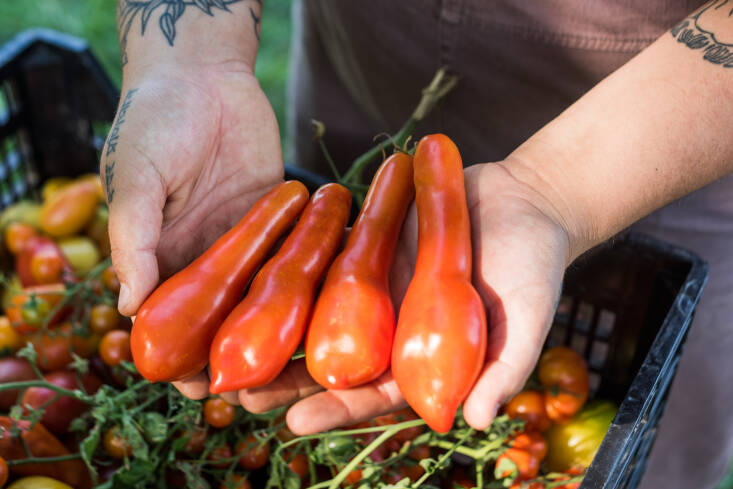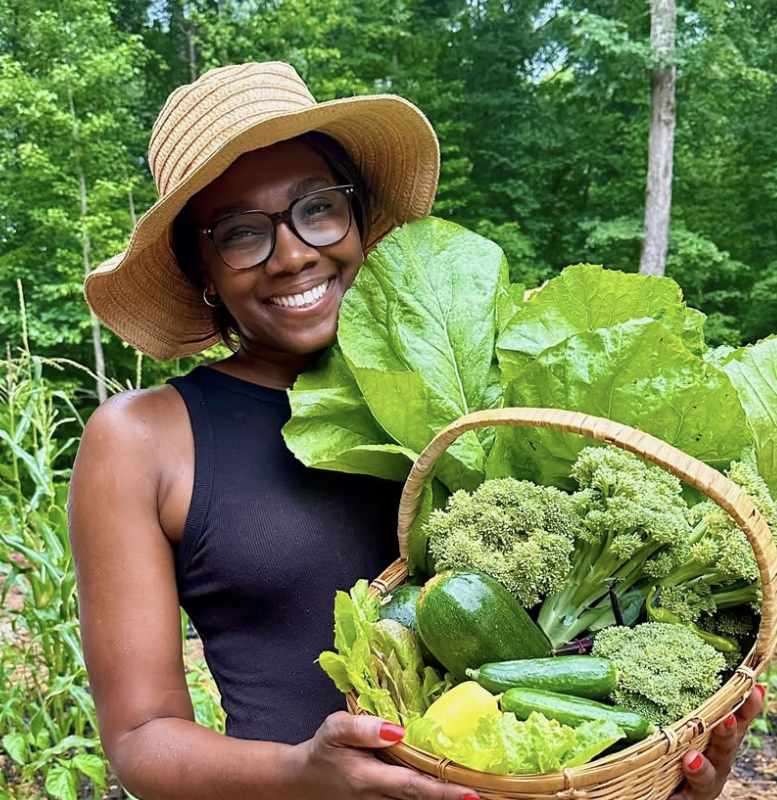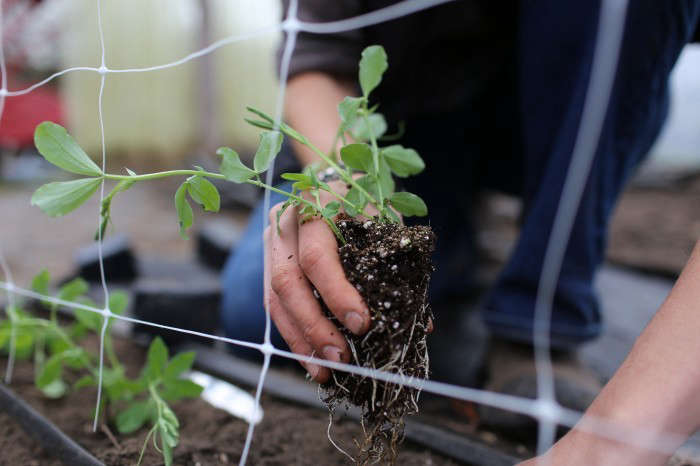When Tim Mountz was given some of his grandparents’ forgotten beans as a young man, he became intrigued by the genealogy of heritage plants: one of the beans was so rare that it had been extinct—until then. He was already a fan of tomatoes, having worked on an organic tomato farm: “That was the first place I had an heirloom tomato and I had a backstage-Jefferson-Airplane-psychedelic experience; it was amazing.” The tomato was Black Krim, a lodestar in his career as a grower of 600 heritage varieties at Happy Cat Farm in Pennsylvania. If you thought you knew all about tomatoes at the decadent end of summer, you haven’t met Tim. Below, his thoughts on a lifetime of cultivating tomatoes.
Photography by Valery Rizzo.
Grow what you love.

Growing what you love is a good place to start. “The two foods I’m always thinking about are pizza and tacos,” says Tim. He grows (and sells) three hot peppers for pizza, five peppers for tacos as well as tomatillos for salsa. Tim sells everything to do with tomatoes, including seeds, plants, sauce, jam—and tomatoes. “They make people happy; they make people swear in front of their kids when they bite into one; there’s just so much passion.”
Heirloom is the way to go.

Tim is a great supporter of open-pollinated varieties, a wider selection than the heirloom group (in which a variety needs to be at least 50 years old). “An open-pollinated variety is one that you can save the seeds from. It’s not genetically modified or hybridized. They all have stories, so I think they’re all important. I call Green Zebra an heirloom, even though it’s from 1984 and isn’t quite there yet.”
Grow together what goes together.

“I have about 100 basil plants growing in the field this year. If I’m depressed, I just grab some and bury my face in it. Basil makes me hungry and happy.”
Don’t prematurely harvest.

It is tempting to pick tomatoes when they have a bit of a flush but it’s a more considered process: “You have to wait till it feels right, and smells right,” says Tim. When a tomato loses some shine, taking on a more matte look, it is a day or two away from color breaking on it. “And then it goes from the breaking stage to the plus stage,” says Tim, and it can be picked at any time. Rushing means losing flavor.
With a green variety, it’s important to wait for a color change too; green tomatoes become more yellow. Even with a mid-green like Green Zebra, the stripes go slightly yellow.
There is no such thing as a glut.

If you have no time to make sauce with a surplus of tomatoes, core them and put them in a freezer. Splitting in tomatoes is caused by a heavy rain just as the fruits are ripening; tomato aficionados watch the weather and relax in the morning if the weather is fine or harvest when rain is predicted. Splitting is a visual imperfection that is more of a problem for sellers of tomatoes than sauce- or Bloody Mary-makers.
There’s a neat way to store them for winter.

“I’ve been trading with a young pizza maker and tomato grower from LA,” explains Tim, ‘He’s got me hooked on Italian ‘storing tomatoes’: you cut them on a truss, take a piece of string, tie it in a loop and then just make this cascade of tomatoes. And in January, you’re still eating them. There is an Italian saying that a wrinkled hand makes a better broth.” By this time, the tomatoes are wrinkly too, but full of flavor.
Collect seeds to complete the circle.

The important facts to know when saving seed are to select fruit at optimum ripeness and cut it in half. Seeds are put in a cup, to which water is added for a short fermentation. After rinsing them clean, seeds need to be air-dried in a warm place, then stored out of direct sunlight, and avoiding humidity fluctuations. In Tim’s case, they are kept in zip-lock plastic bags in a filing cabinet in the basement. “Tomato seeds are viable for a very long time. At about eight years, they start to drop off but it’s slow, especially if they are stored properly.”
Putting a tomato in the fridge is a terrible idea.

“Refrigeration slows the ripening process in a way that makes tomatoes change in not great ways. It is much better to let them go ripe and freeze them whole and lock in the greatness of this sweet fleeting season we call summer.”
Tomatoes aren’t all sweet.

If Tim could choose just one tomato, it would probably be Black Krim (from Crimea): “It’s salty, and savory, and intense. Not like the the whites or the yellows that are giddy and sweet, and super-summery; it’s the thinking man’s tomato.” Other favorites are Brandywine, which couldn’t be more local, since his tomatoes are watered via the Brandywine River, and every type of peach tomato. “It’s fuzzy-skinned; it looks like a peach, with more of a matte finish to the tomato. They don’t really taste like peaches but they do have a certain little fruitiness.”
You can eat too many tomatoes—but it’s worth it.

“I do get mouth sores,” admits Tim, adding that he doesn’t care. Tomatoes have a generously wide spectrum from savory to sweet, so the acidity can be balanced.

“The day I dream of is the day when I lay down in bed, and close my eyes, and I think to myself, ‘I ate nothing but tomatoes today.’ I fall asleep, and that’s all I think of.”
For more on tomatoes, see:
- How Many Tomatoes Does It Take to Fill a Canning Jar?
- Gardening 101: Everything You Need to Know About Growing Tomatoes
- Garden-to-Table Recipe: Fried Green Tomatoes from a Cook’s Garden








Have a Question or Comment About This Post?
Join the conversation